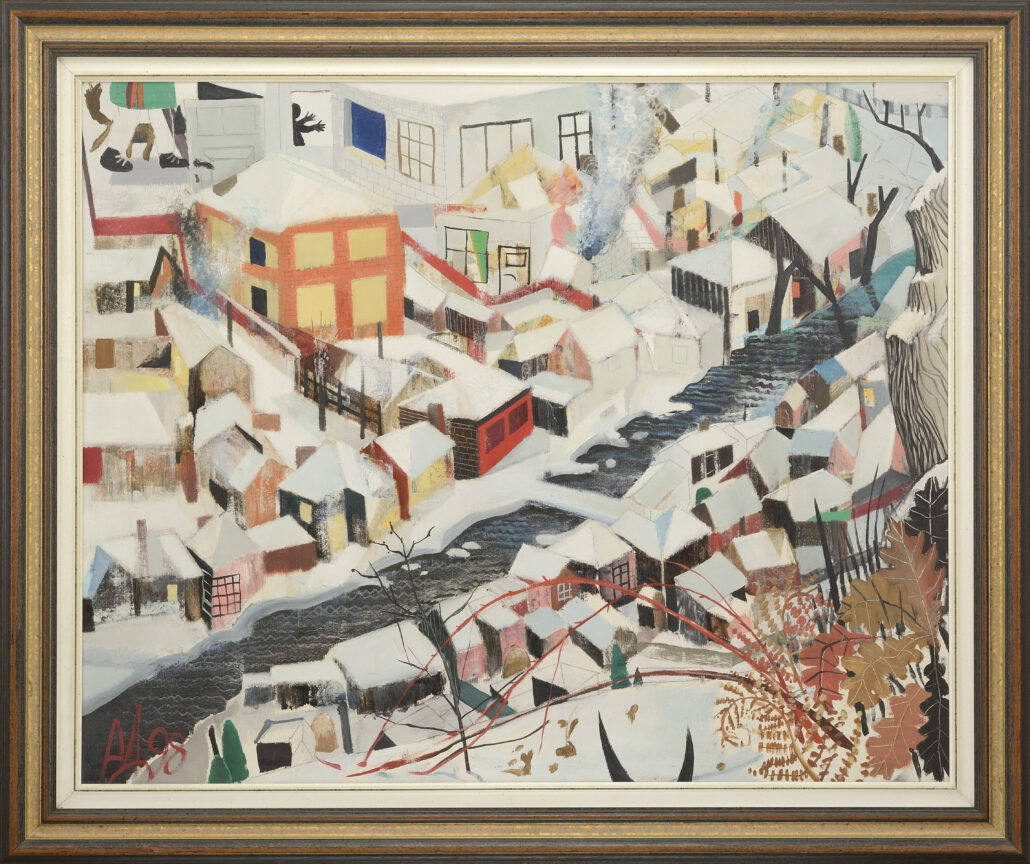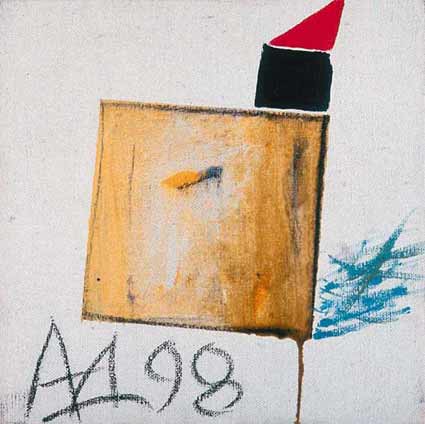We begin the presentation of the works of fine art in the Spring Auction 2024 with what for the author of the text is one of the most precious jewel among them – both in terms of content, technique and innovation, as well as its extremely interesting story, but also its intellectual charge. This is the work of Andrey Daniel (1952-2020), whom we soon and untimely lost – Landscape from Lessidren I, 1998.
The story of the painting
I will begin in an unusual way, as the author is unusual – with the history of the painting. Two works with this name are known as a result of Andrey Daniel’s participation in the first of a series of famous Lessedra Gallery plein-air painting (Gallery Lessedra, 1998), organized by Georgi Kolev in his native village of Lessidren, Troyan Region, which took place between January 17 and February 10, 1998 at the “House of the Cinematographers”. Twenty-four Bulgarian artists, representatives of art criticism, journalists and art connoisseurs participated in the plein air. A further 20 artists joined the project with their own works and participated in a major exhibition, accompanied by a catalogue, organised between 5 and 17 June of the same year in the Salon of the Arts of the National Palace of Culture in Sofia (Kolev, Georgi, 2008). In October of that year, the exhibition visited the Bulgarian cultural centre in Vienna, “Wittgenstein House”. The catalogue published then in three volumes (Contemporary Bulgarian Art, 1998), in which Daniel’s landscapes are documented, is still one of the best examples of a professional guide to contemporary Bulgarian art (“Lessedra” Gallery, 2006).
Journalists and art historians writing about the plein air do not fail to mention Andrey Daniel and his works. Most often they illustrating their articles with the oil canvas “Landscape from Lessidren I” offered in our Spring Auction (Whiteman, Bruce, 1998 , Kolev, Georgi, 2008 , Alexandrov, Alexandar, 2008) – clearly the strong charge of the work has made an impression on all observers in that time.
That, in a nutshell, is the rich history and documentation of the extraordinary work you will have the opportunity to acquire. It is the history and documentation that makes the artwork extremely valuable, because it provides a rich context from which meanings and ideas can be drawn, and a narrative can be constructed that brings an understanding in depth, opening our perceptions to the words and meaning of the painting.
The Three Landscapes of Lessidren
Andrey Daniel has made three works in Lessidren, as the plein air conditions were. Besides the catalogue, they became popular through the rich website of the Lessedra Gallery (Andrey Daniel’s participation). The first impression made by the genre and subject chosen is that the artist is the kind of honourable person who feels and expresses a strong respect for the other who has opened up to him. In this case, he expresses his respect for the place and the gallerist who invited him to the plain air. Although fanciful, he paints landscapes of the particular place to which he is invited. Although he paints abstractly, he also displays a specific flavour of conservatism and traditionalism. We hear him speak at lectures about the importance of purity of genre: “The viewer should not be confused. The genre sets some limits within which it can be shown, made easily visible – the innovation, the discovery of the artist. The purity of genres is one of the weapons in painting. Genre is an old language of fine art.” (Daniel, Andrei, 2010).Presented and arranged together, his three paintings create an even richer context of their own, complementing each other and helping us to understand them better. “Landscape from Lessidren I” is the most realistic, at least when viewed from a distance. Daniel has observed winter Lessidren from high above and in nature, presumably from the “House of the Cinematographers” where the artists resided. Despite the high and distant viewpoint, the canvas is full of dozens, perhaps hundreds of tiny details that are virtually impossible to perceive by the eye from afar. When we look at them, we realize that the landscape is somehow both realistic and completely fantastical, fairy-tale-like, as if seen in a dream, in which dream you recognize without a doubt that you are seeing the particular place, even though it is very unlike the place you know when you are awake. It does not look like the real thing, yet you recognize it flawlessly – this is the first mastery of Andrey Daniel that I will note in my analysis.
“Landscape from Lessidren II” is a close-up view of a piece of a street, on which piece two houses and three roofs fit. A strip of winter fog bisects the houses. The strip, in turn, becomes a background for highly enlarged human figures representing local villagers, painted upon the fog in the style of street graffiti. The small canvas is completely abstract. In it, clear geometric elements from the shapes of rural houses are combined in such a way as to give the impression of an image of a stuck orange flag with a black chimney from which a bright red triangular smoke-fire whistles upwards. The flag has a contrasting blue shaggy bird’s tail, which is strangely reminiscent of the River Lessidrenska. It is only at this point in the description that I notice something bright orange tucked into the middle of the orange square and which can be seen as both a bird’s beak and an arrow hitting the target.
Arranging the three works side by side allows us to see how the reduction has moved from the more realistic-fantastic to the more abstract-fantastic and finally to the pure abstraction of objects and forms. It gives us an opportunity to realise what are the most significant colours in Andrey Daniel’s experience of the wintery, predominantly white, Lessidren. Obviously, it is the colours of the small composition – orange, red, blue and black (on a misty-snowy white-greyish background), which colours immediately catch the eye in both large landscapes. The little green in the large paintings had completely dropped in the third – it has clearly not proved to be characteristic of the Lessidren winter landscape. The two flanking landscapes are strikingly similar, as if the third is derives directly from the first. It seems so because in the second landscape Daniel has covered the houses with a strip of fog, which he has turned into a canvas-wall with street graffiti of shadow-people. Probably they are typical Lessidren character-images – a drunkard with an orangy hand and rosy cheeks, a black old woman with a cane and a sign-human figure with a red head running towards the exit. Of these, only the drunkard has life and vitality. There are no human figures in the small composition. In the first landscape there are three partially represented figures huddled in the upper left corner – a piece of a shadow of a man, a piece of a drawing of a man accompanied by a fox. Although they are pushed into the corner, they are paradoxically huge; hence, they are an important, if not the most important element of Landscape I.
We will take a closer look at the “Landscape from Lessidren I” in the second part of the text.
Rossitsa Gicheva-Meimari, PhD
Senior Assistant Professor in the Art History and Culture Studies Section and member of the Bulgarian-European Cultural Dialogues Centre at New Bulgarian University
April 2024
Bibliography:
Alexandov 2008: Александров, Александър, 2008. Пленерите на Леседра. В: Kafene.bg – https://kafene.bg/%D0%BF%D0%BB%D0%B5%D0%BD%D0%B5%D1%80%D0%B8%D1%82%D0%B5-%D0%BD%D0%B0-%D0%BB%D0%B5%D1%81%D0%B5%D0%B4%D1%80%D0%B0/ Accessed 10.04.2024
Andrey Daniel’s participation: Участието на Андрей Даниел в пленера на галерия „Леседра“ – https://www.lessedra.com/workshop98artistsinfo.php?artistid=2 Accessed 10.04.2024
Boykova 1998: Бойкова, Милена, 1998. Лесидрен се окичи със сняг и картини. – в. Демокрация, 4.02.1998 – http://www.lessedra.com/lesidren.php Accessed 10.04.2024
Daniel 2010: Даниел, Андрей, 2010. Концептуалността в живописта. Един субективен поглед. Видео от публична лекция на проф. Андрей Даниел от 14 май 2010 г. – https://www.facebook.com/watch/?v=250555639665427 Accessed 10.04.2024
Daniel 2017: Даниел, Андрей, 2017. Андрей Даниел и вечните разкази. Интервю с А. Даниел – Християнство и култура, 2017, бр. 121. – https://kultura.bg/web/%D0%B0%D0%BD%D0%B4%D1%80%D0%B5%D0%B9-%D0%B4%D0%B0%D0%BD%D0%B8%D0%B5%D0%BB-%D0%B8-%D0%B2%D0%B5%D1%87%D0%BD%D0%B8%D1%82%D0%B5-%D1%80%D0%B0%D0%B7%D0%BA%D0%B0%D0%B7%D0%B8/ Accessed 10.04.2024
Dzhambazov 2020: Джамбазов, Стефан, 2020. Последните 7 години на художника Андрей Даниел в галерия “Академия”. В: Impressio – https://impressio.dir.bg/palitra/poslednite-7-godini-na-andrey-daniel-v-galeriya-akademiya Accessed 10.04.2024
Dzhambazov, Almaleh 2022: Джамбазов, Стефан, Зелма Алмалех, 2022. Андрей Даниел и неговите острови… Във: Въпреки – https://въпреки.com/post/679943107638378496/%D0%B0%D0%BD%D0%B4%D1%80%D0%B5%D0%B9-%D0%B4%D0%B0%D0%BD%D0%B8%D0%B5%D0%BB-%D0%B8-%D0%BD%D0%B5%D0%B3%D0%BE%D0%B2%D0%B8%D1%82%D0%B5-%D0%BE%D1%81%D1%82%D1%80%D0%BE%D0%B2%D0%B8 Accessed 10.04.2024
Kolev 1998: Колев, Георги, 1998. Съвременно българско изкуство. Едно лично гледище, Том 3, Галерия “Леседра”, София, 1998, с. 176, 338. Contemporary Bulgarian Art. A Personal View. Lessedra Gallery, Sofia 1998, p. 176, 338.
Kolev 2008: Колев, Георги, 2008. Пленерите на Леседра. В: Културни новини – https://kulturni-novini.info/sections/2/news/5242-plenerite-na-lesedra Accessed 10.04.2024
Lardeva 2021: Лардева, Галина, 2021. Сантименталистът конструктивист между епохите. В: Портал за култура, изкуство и общество, 18.05.2021 – https://kultura.bg/web/%D1%81%D0%B0%D0%BD%D1%82%D0%B8%D0%BC%D0%B5%D0%BD%D1%82%D0%B0%D0%BB%D0%B8%D1%81%D1%82%D1%8A%D1%82-%D0%BA%D0%BE%D0%BD%D1%81%D1%82%D1%80%D1%83%D0%BA%D1%82%D0%B8%D0%B2%D0%B8%D1%81%D1%82-%D0%BC%D0%B5%D0%B6/ Accessed 10.04.2024
Lessedra Galery 1998: Галерия “Леседра”, 1998. Изложбата. Workshop Lessidren Winter 1998. http://www.lessedra.com/izlojbata.php Accessed 10.04.2024
Lessedra Galery 2006: Галерия “Леседра”, 2006. Живопис без рамка: картини от един почти (не)случил се пленер. В: Културни новини – https://kulturni-novini.info/sections/2/news/1611-zhivopis-bez-ramka Accessed 10.04.2024
Vassilev 2017: Василев, Кирил 2017. Брокат, инкрустиран с рубини и диаманти. Разговор с Андрей Даниел. В: Култура, бр. 3 от 27 януари 2017 – https://newspaper.kultura.bg/bg/article/view/25624 Accessed 10.04.2024
Whiteman, Bruce 1998: Уайтман, Брус, 1998. Бягство със снежната кралица. – The Sofia Independent, 27.02.1998 – http://www.lessedra.com/lesidren.php Accessed 10.04.2024



